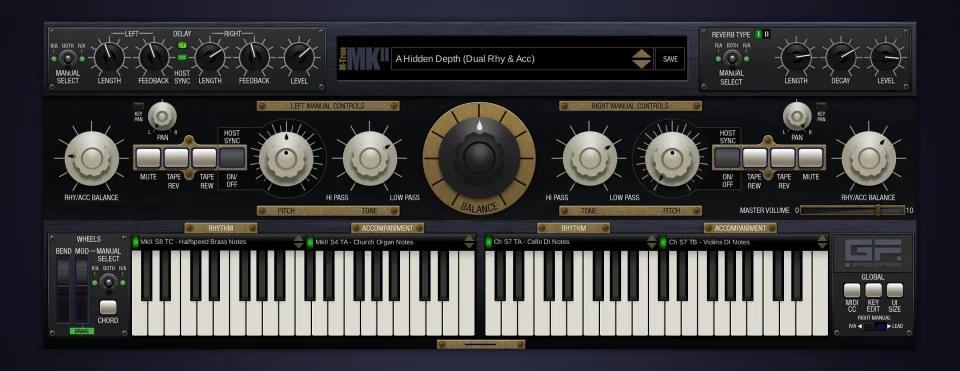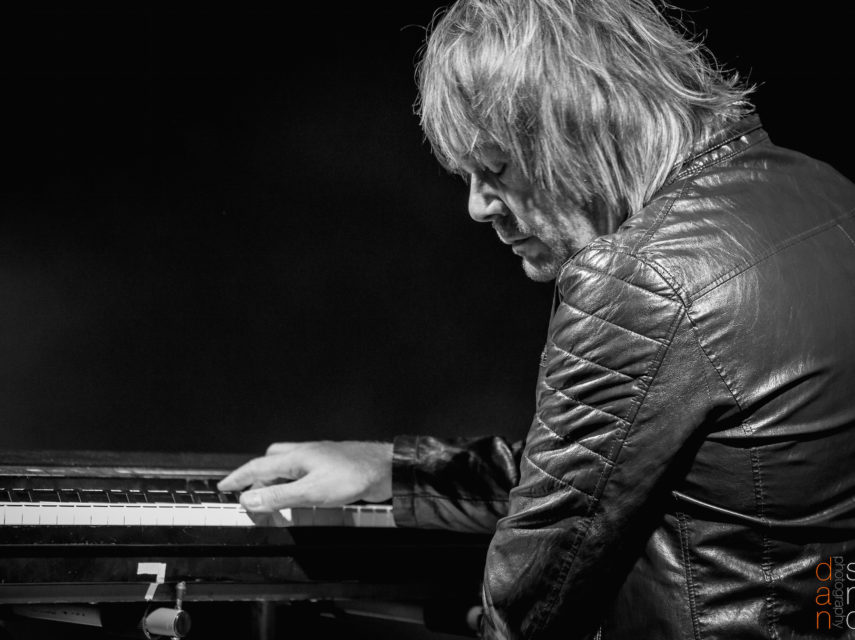February 1, 2022
by GForce Software
When Nigel Hopkins got his hands on M-Tron MkII he set to work recreating some of the most iconic Mellotron MkII tracks in the most amazing detail. Here we present Nigel’s amazing work along with wonderfully detailed and humourous notes provided by Nigel.
Please note the videos below have, rather unsurprisingly, triggered YouTube’s copyright algorithms and they have been flagged to include adverts. The money for which will wind it’s long merry way back to the copyright holders. You can hear the quarter-pennies stacking up already…
Find out more about Nigel and his work at his website here.
Free MIDI & Patches
Nigel has also kindly saved out his patches and MIDI files from the videos below. These are available to all registered M-Tron MkII owners in their accounts now.
Update 11th Feb 2022:
Today we have heard the sad news of Ian McDonnald’s passing. Ian’s legendary work with King Crimson and Foreigner is one of the main reasons so many of us love the Mellotron. We all own him a great debt and we’d like to pay tribute to him here.
Watcher Of The Skies
Opening up their fourth album “Foxtrot” album in 1972 and recorded at Island Studios, “Watcher of the Skies” became one of the most iconic Mellotron intros of the Keyboard World. Once you hear that chord, you know what song it is.
According to Tony Banks, the introductory section was intended to take advantage of idiosyncrasies in the tuning of the Mellotron model he was using at the time:
“It was intentionally melodramatic to conjure up an impression of incredible size. It was an extraordinary sound. On the old Mellotron Mark 2 there were these two chords that sounded really good on that instrument. There are some chords you can’t play on that instrument because they’d be so out of tune. These chords created an incredible atmosphere. That’s why it’s just an incredible intro number. It never sounded so good on the later Mellotron.”
I remember watching Genesis in September last year. Waiting, longing, yearning for those two Introductory chords, but sadly it wasn’t to be. I guess they’d be exiled in 1972/73.
Attributed to all Genesis members Tony Banks, Phil Collins, Peter Gabriel, Steve Hackett and Mike Rutherford this song became a legend in the world of the MKII Mellotron thanks to Tony’s incredibly filmic intro.
Main thing was to make sure the right chords were played for the intro.
With that Big B minor 7 sharp 9 chord (and adding G# into the chord).
I was able with the original Hammond part (for which every man on the internet has opinion on what this chord is….but not on what his wife wants for Christmas) to kind of get close to the original.
The First two chords of this, B major 7/F# Bass and C#/F#bass, and you know the song instantly what it is. Unless you don’t play keyboards, don’t understand Music, Have no interest in Prog Music, Haven’t heard the album or have zero desire the further your intellectual capacity….This track is a thing of beauty though. Surely one of the best intros on Mellotron EVER!

Strawberry Fields Forever
Written by John Lennon, this song was recorded in the first session after “Revolver” and what would become known as the “Sgt Peppers Lonely Hearts Club Band” Sessions.
All recorded in studio 2 at Abbey Road Studios, The Beatles recorded many versions of the song, in different keys with different tempos, so when the final edit was due to be decided upon, John Lennon and George Martin decided to opt for Take 7 which was lighter in feel and take 26 with the orchestra, which was in a higher key and at a faster Tempo, but was more intense.
Lennon then left the task to Martin to splice both versions together. George Martin was armed with only a pair of scissors and a vari-speed control for the tape, hence matching the tempos and keys created a speed up in tempo for verse 3 at around 57 seconds as it was recorded in the higher key and much faster. The first edit comes in at half way through the vocal re intro to verse 3.
The iconic Mellotron MKII Flute intro was played by Paul McCartney.
I delved into the archives of The Beatles recordings to figure out what they would have done on the recording process. I did find out that they recorded the Mellotron with the tape running faster…which would account for the lack of Top end as when it came back to centre/440….it wouldn’t be as bright and the formants would have shifted.
This would account for the fact that despite the best ears in the industry at the time, vari-speeding the tape up WITHOUT actually having a reference tone would mean it was hit or miss.
I wanted to find out just how far out it all is. So I tried this on my M-tron MkII Flute patch and to give you an idea the Master Tune is fully to the right! It is so far out, it had to pay to get back in.
The Beatles once said “We used a Mellotron on Strawberry Fields. I didn’t think it would get past the Musicians’ Union, so we didn’t advertise it”.
The idea, that you’d sample someone’s instrument and use it on a keyboard to emulate them….Who’d do such a thing eh!

Nights in White Satin
Originally first released back in 1967 by the Moody Blues and written by Justin Hayward, This song featured the Mellotron MKII and appeared on the Moody’s album “Days of Future Passed”.
Mike Pinder played the Mellotron MKII on this timeless classic.
It was pretty much the one of the only keyboards available that could produce the sound of strings-years before any string machines were let loose on the wallets of the unsuspecting keyboard players and producer.
The Mellotron MKII tape bank is called “3 Violins” and was rumoured to be originally recorded for the Chamberlin in Harry Chamberlin’s home by 3 ladies. I believe this is the only Chamberlin tape library that ended up on a Mellotron.
Due to the recording techniques of the late 60’s and no DI’s being available at Decca Studios, the Mellotron was fed through a Marshall amp and speaker and mic’d up with a Neumann U67.
Extensive use of the MKII volume pedal was used to fade in the strings.
Reverb was used (which would have been either an echo chamber or one of the EMT plates).
When I tried to recreate “Nights in White Satin”, the first thing was to construct the rhythm instruments and then lay the MKII on top.
There are a lot of swells in volume on this track.
The Chorus, as I’m told, has the combined Brass, but I opted to put this down as an overdub. The choir on this video is from M-Tron Pro.
EQ wise, It was a case of rolling the top end off in order not to have that edgy sound and to emulate the warmer softer edges of Mike’s original recording.

In The Court of the Crimson King
A favourite of mine.
Released in October 1969 on the album of the same name, it featured the Mellotron MKII work of Ian McDonald. Recorded in just 10 days at Wessex Studios, this to many was the point at what Prog Rock was born and entered our world.
£15,000GBP it cost to record this incredibly evocative album.
Considering that “Strawberry Fields Forever” took 45 hours over seven weeks, to make an album of this magnitude is an incredible feet. Such accomplished musicianship and dedication.
It was written by Ian McDonald and Pete Sinfield.
It actually started life as a country and western song.
Maybe there is a side project here waiting to happen – “Stand by your 21st Century Schizoid Man”, “I Talk to the Trees (and Wind”) “In The Court of The Crimson Jack To A King”. OK, I’ll shut up (Sorry Robert and the KC Team).
Those incredible sounding Mellotron parts were recorded according to Ian through a Speaker and amp set up in the live room and mic’d about 30 feet away. That would account for all the reverberation and that huge sound.
If John Bonham had recorded “When the Levee Breaks” in the bathroom at Headley Grange, it wouldn’t have sounded anything like that incredibly massive drum track.
Recreating ITCOTCK for me was something I needed to get off my chest. Lots of stories as to why, but for one main reason: it was my first encounter with the sound of keyboard strings.
The main Mellotron part is played in octaves and echoed by the vocals later in the chorus’s. It is such an incredible riff that the moment you hear it, 1969 is back. Robert Fripp has continued to tour King Crimson over the last 10-12 years and the last time I saw them live, those first four drum hits were like an explosion in the building. My head fell off! And has never been back on since.
Considering they were using 3 Drummers…..that’s a big sounding drum fill.
Now, to summon back the fire witch…..To The Court of the Crimson King.
EQ wise, All I tried to do was figure out what a WEM or MARSHALL PA Column stack would sound like back in the 60’s. Void of any top end above 3KhZ and evoking the furious head shaking of someone who was in need of ear syringing.
Recreating the track, I started with the drums and bass, then added Harpsichord, Piano, Octave Piano Bass, organ and Guitars and then added that wonderful top line.

Starless
“Starless” featured on 7th King Crimson’s album “Red” in 1974 when they became a power trio with Robert Fripp, John Wetton and Bill Bruford (who was used to a Mellotron or two with Rick Wakeman by then).
The original chords and melody were written by Wetton for the “Starless and Bible Black” Album, it never made the cut, but resurfaced to be worked on for the “Red” Album
The Song features The 3 violins tape bank, available on both the MkII and M400, and was played by Mr Fripp. I think the track used an M400 but I decided to show how great the 3 violin tapes are, and how they can be EQ’d to sound like Fripp’s original M400 recording. The original melody was played in its early incarnation by David Cross on Violin, but Fripp eventually re worked it and played it on guitar. The song also features Mel Collins on Soprano Sax and Ian McDonald on Alto Sax.
I’ve seen this being played live on the last three tours with King Crimson. Jakko Jakszyk does an incredible job of resurrecting the emotion that John Wetton evoked, but managing to put his own stamp on it too….and what a performance too. The Hairs on the back of my neck stood up. That latest reincarnation of King Crimson is not known as the Seven Headed Beast for nothing. Incredible musicianship.
With the EQ, I was aware that recording Processes were now starting to get fancier, better, more polished….so gone are the days of no DI’s available in the studios. This was recorded at Olympic Studios which was an incredible studio in the day. Brain Salad Surgery was recorded there. Led Zepplin albums were recorded there. Artists such as Procol Harum, Scott Walker “Scott 4”, The Faces, Queen “Night of the Opera”, “Who’s Next” by the Who, and also including Monty Python’s “Life of Brian” Soundtrack.
So upon listening I found there were similar EQ techniques used to limit the frequency range of the M400 as with the MkII.
Smothered in Reverb, It is one of the iconic sounds of the Mellotron for me.

Explore More
Marius Leicht Plays M-Tron MkII
Shop

